1. Introduction
The study of Archaean greenstone belts, in particular their formation and geodynamic context, raises complex questions and is the subject of intense debate among geologists. One of the main points of discussion concerns the role of subduction-related tectonic processes similar to those observed in the Phanerozoic, in the formation of these belts (Bédard, 2006; Bédard, 2013; Polat and Kerrich, 2006; Bédard, 2013; Wyman, 2013). The mechanisms of crustal growth, whether influenced by subduction or mantle plume-related processes, have profound implications for Earth evolution and metallogenesis during the Archaean.
In the Tasiast region, Mauritania, the Lebzenia Group, still poorly studied, has been interpreted, along with the neighbouring Talhayet and Sebkhet Nich formations, as a volcanic arc formed in a subduction context after a phase of continental-to-oceanic rifting, with typical enriched MORB signatures (Pittfield et al., 2005).
There is a general consensus that a horizontal tectonic framework led to the terrane accretion events documented in the western part of the Superior Province (Goodwin, 1981; Percival et al., 2006; Stott et al., 2010; Bédard, 2013; Wyman, 2013). In this context, the present study aims to investigate in detail the geochemical characteristics of the Lebzenia Group metabasites. These rocks show a notable similarity with the mafic volcanic rocks (basalts) of Ungava, located north of the Superior Province, Quebec (Lamothe, 2007; Corrigan et al., 2009), as well as to those of the Wawa-Abitibi terrane, the Tanzanian craton, and the Dharwar craton in India, which are reminiscent of modern volcanic arcs (Polat, 2009; Wyman and Kerrich, 2009; Lodge et al., 2014).
Recent studies of Archaean greenstone belts suggest that they formed in various tectonic environments, including subduction zones, volcanic arcs, and back-arc basins, illustrating the geological complexity of these regions (Condie, 1981; de Wit, 1998; Polat, Kerrich and Wyman, 1998). The presence of complex lithological associations, such as tholeiitic basalts, komatiites, and ultramafic rocks, along with evidence of high-pressure metamorphism, indicates that diverse tectonic processes operating during the Archaean (Wyman, 1999; Kerrich and Polat, 2006; Furnes et al., 2009).
We aim to contribute to this debate by studying the Tasiast greenstone belt in Mauritania. Similar to those of the Archaean cratons in Canada, Australia, and West Africa, these belts are known for their rich gold deposits (Polat and Kerrich, 2002; Sylvester and Attoh, 1992). The Tasiast belt, in particular, hosts one of the largest orogenic gold deposits in West Africa, with over 10 million ounces of confirmed gold (Stuart, 2010). This not only highlights the economic value of the region but also its importance in international geological and mineralogical discussions.
Orogenic gold deposits, such as those at Tasiast, are generally associated with greenstone belts, which have been shown to form in tectonically active environments, involving processes such as subduction, continental collision, and mantle plumes (Stern and Hanson, 1991; Windley, 1995). This region frequently attracts the attention of geologists at international conferences, such as those organised by the Geological Society of America or the International Union of Geological Sciences, where the geodynamic and economic implications of greenstone belts in Archaean cratons are discussed.
A key question regarding the Tasiast belt is to understand its tectono-magmatic origin. Do the processes that shaped these rocks reflect a tectonic regime similar to modern volcanic arcs, dominated by subduction, or do they show distinct geochemical signatures resulting from alternative processes, such as mantle plumes or back-arc environments? Answering this question is essential for reconstructing the tectonic and thermal conditions of the Archaean, a key period in Earth’s evolution.
2. Materials and methods
In the Tasiast region, eight samples were collected from the greenstone belts for in-depth studies of their petrographic composition and detailed analyses of their major and trace elements. These samples were carefully selected to represent the geological diversity of the region and were collected from strategic locations to obtain a representative picture of the chemical composition of the study area. Table 1 lists the collected samples, along with their respective GPS coordinates (Figure 1). Whole-rock analyses, were done at the Andalusian Institute of Earth Sciences in Armilla, Granada, Spain, using two analytical techniques: Inductively Coupled Plasma Mass Spectrometry (ICP-MS) and Wavelength Dispersive X-ray Fluorescence Spectrometry (WD-XRF). The ICP-MS method was used to determine the trace element composition of the samples. The Wavelength Dispersive X-ray Fluorescence Spectrometry (WD-XRF) was used to analyze the major elements present in the samples.
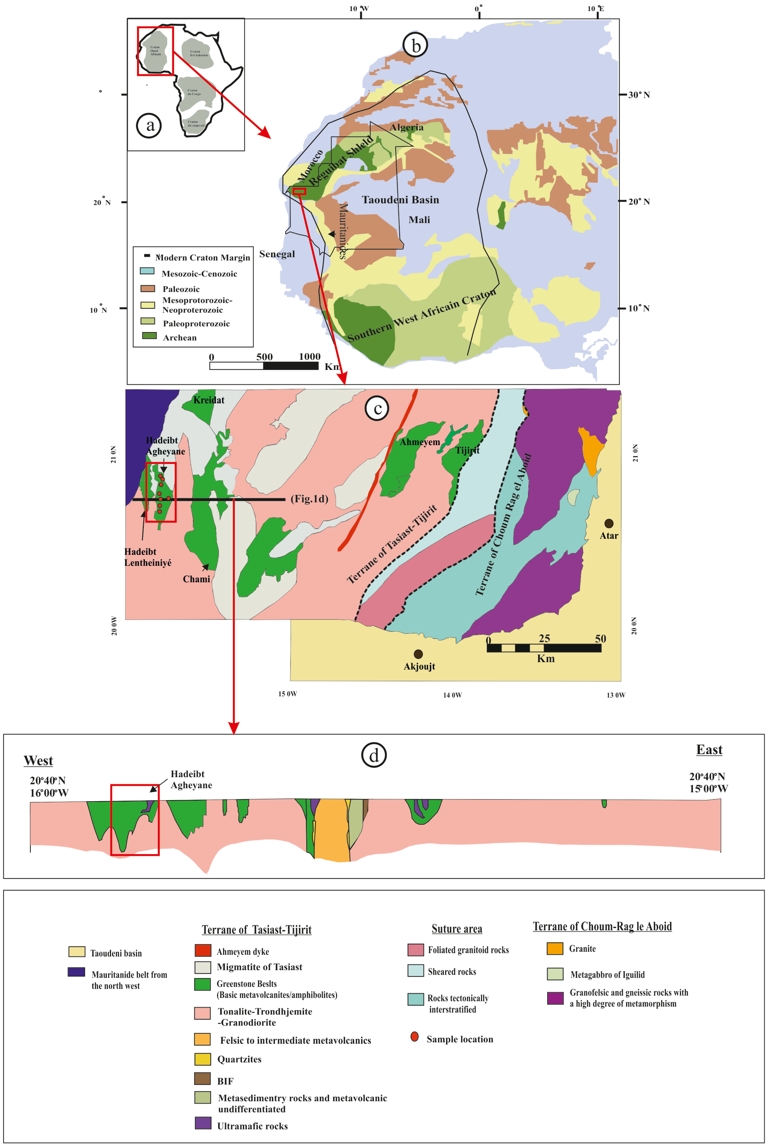
(a) The geographical distribution of cratons in Africa (Begg et al., 2009). (b) Geological framework of the West African craton showing the location of the studied Tasiast area in Mauritania (Heron et al., 2016). (c) The main litho-tectonic units of the Reguibat shield (modified from Pittfield et al., 2005) (d) Section (east–west) of the Chami sector, Tasiast–Tijirit Terrane.
Major (wt%) and trace element (ppm) analyses of metabasites from the greenstone belt, collected from the Lebzenia formation in the Tasiast complex
| Metabasites Lebzenia from the Tasiast | Sebkhet Nich | Talhayet | |||||||||
|---|---|---|---|---|---|---|---|---|---|---|---|
| Sample N | DRAM 1 | DRAM 3 | DRAM 6 | DRAM 7 | DRAM 8 | DRAM 9 | DRAM 10 | Métavolcanite | Amphibolite | Amphibolite | Métavolcanite |
| SiO2 | 53.04 | 54.85 | 51.57 | 58.47 | 46.91 | 50.74 | 50.23 | 48.79 | 49.72 | 53.87 | 46.31 |
| Al2O3 | 15.44 | 13.91 | 15.78 | 13.74 | 14.24 | 16.62 | 15.65 | 22.77 | 14.20 | 14.99 | 15.07 |
| Fe2O3 | 8.53 | 9.75 | 11.08 | 8.14 | 18.13 | 10.24 | 12.19 | 8.03 | 12.78 | 8.46 | 13.56 |
| Fe2O* | 7.68 | 8.78 | 9.97 | 7.32 | 16.31 | 9.21 | 10.98 | 7.23 | 11.50 | 7.61 | 12.21 |
| CaO | 10.93 | 9.44 | 10.57 | 9.34 | 10.32 | 12.23 | 11.89 | 13.51 | 12.11 | 11.80 | 12.56 |
| MgO | 6.77 | 5.85 | 5.86 | 5.18 | 5.26 | 6.88 | 6.94 | 3.72 | 6.68 | 4.21 | 9.95 |
| Na2O | 2.78 | 3.43 | 3.46 | 3.25 | 1.81 | 1.26 | 1.15 | 1.68 | 1.69 | 1.62 | 0.95 |
| K2O | 0.16 | 0.16 | 0.12 | 0.16 | 0.29 | 0.17 | 0.19 | 0.05 | 0.07 | 1.17 | 0.15 |
| TiO2 | 0.68 | 0.69 | 0.67 | 0.65 | 1.05 | 0.40 | 0.41 | 0.50 | 0.83 | 0.76 | 0.72 |
| MnO | 0.12 | 0.17 | 0.15 | 0.13 | 0.23 | 0.19 | 0.19 | 0.10 | 0.19 | 0.19 | 0.26 |
| P2O5 | 0.08 | 0.35 | 0.02 | 0.10 | 0.07 | 0.05 | 0.04 | 0.02 | 0.05 | 0.06 | 0.06 |
| LOI | 0.59 | 0.46 | 0.51 | 0.39 | 0.73 | 0.50 | 0.62 | 0.70 | 0.8 | 3.2 | 0.2 |
| Cr | 85.00 | 55.00 | 95 | 44 | 104 | 10 | 39 | - | - | - | - |
| Zr | 78.00 | 79.00 | 116 | 87 | 39 | 34 | 28 | 25.00 | 39.00 | 47.00 | 26.00 |
| Hf | 2.106 | 2.133 | 3.132 | 2.35 | 1.05 | 0.92 | 0.76 | 0.9 | 1.4 | 1.4 | 1 |
| Ni | 68.00 | 58.00 | 67 | 32 | 26 | 45 | 56 | 5.60 | 20 | 26 | 30 |
| Rb | 2.07 | 4.04 | 2.62 | 5.37 | 2.81 | 1.84 | 7.57 | 1.50 | 1.10 | 41.00 | 1.40 |
| Ba | 176.01 | 189.75 | 191.60 | 169.62 | 288.46 | 85.81 | 123.80 | 38.00 | 24.00 | 287.00 | 31.00 |
| Th | 3.98 | 6.00 | 3.33 | 1.40 | 1.72 | 4.76 | 1.45 | 0.10 | 0.10 | 0.60 | 0.10 |
| U | 0.72 | 0.87 | 0.84 | 0.29 | 0.36 | 0.78 | 0.50 | 0.05 | 0.05 | 0.50 | 0.05 |
| Nb | 2.83 | 4.10 | 0.50 | 3.48 | 1.20 | 1.40 | 2.79 | 1.81 | 1.60 | 1.90 | 1.50 |
| Ta | 0.29 | 0.30 | 0.32 | 0.12 | 0.13 | 0.27 | 0.15 | 0.10 | 0.10 | 0.10 | 0.10 |
| La | 5.22 | 42.94 | 31.39 | 3.39 | 3.69 | 7.48 | 4.44 | 1.70 | 2.40 | 4.00 | 1.80 |
| Ce | 13.02 | 78.41 | 17.10 | 7.35 | 8.75 | 16.10 | 9.40 | 4.10 | 6.20 | 9.00 | 5.80 |
| Pb | 3.31 | 1.49 | 1.10 | 2.57 | 2.49 | 1.63 | 1.37 | 0.20 | 0.10 | 1.30 | 0.40 |
| Pr | 1.64 | 8.37 | 13.21 | 0.87 | 1.02 | 2.02 | 1.30 | 0.62 | 0.87 | 1.10 | 0.93 |
| Nd | 6.98 | 30.03 | 53.99 | 3.53 | 4.32 | 8.84 | 5.45 | 3.50 | 5.30 | 5.80 | 5.00 |
| Sm | 1.91 | 6.18 | 12.04 | 0.95 | 1.19 | 2.42 | 1.43 | 1.10 | 2.00 | 2.10 | 1.90 |
| Eu | 0.69 | 0.88 | 3.28 | 0.36 | 0.47 | 0.91 | 0.53 | 0.52 | 0.68 | 0.77 | 0.79 |
| Gd | 2.48 | 7.50 | 10.45 | 1.23 | 1.55 | 3.10 | 1.93 | 1.40 | 2.80 | 2.20 | 2.50 |
| Tb | 0.41 | 1.09 | 1.50 | 0.21 | 0.26 | 0.49 | 0.32 | 0.27 | 0.48 | 0.45 | 0.47 |
| Dy | 2.87 | 7.05 | 8.85 | 1.51 | 1.88 | 3.45 | 2.21 | 1.70 | 3.40 | 2.90 | 3.30 |
| Y | 17.23 | 39.71 | 34.21 | 8.63 | 10.74 | 20.36 | 12.73 | 11.00 | 20.00 | 17.00 | 18.00 |
| Ho | 0.66 | 1.49 | 1.64 | 0.33 | 0.40 | 0.76 | 0.50 | 0.35 | 0.62 | 53.00 | 0.70 |
| Er | 2.00 | 4.21 | 4.41 | 0.99 | 1.24 | 2.30 | 1.48 | 1.20 | 2.10 | 1.70 | 2.00 |
| Tm | 0.28 | 0.56 | 0.63 | 0.15 | 0.18 | 0.33 | 0.21 | 0.16 | 0.03 | 0.22 | 0.28 |
| Yb | 1.91 | 3.46 | 4.00 | 1.00 | 1.17 | 2.13 | 1.41 | 1.30 | 2.00 | 1.40 | 1.90 |
| Lu | 0.30 | 0.53 | 0.61 | 0.16 | 0.19 | 0.33 | 0.22 | 0.16 | 0.24 | 0.21 | 0.28 |
| Mg# | 0.61 | 0.54 | 0.51 | 0.56 | 0.37 | 0.57 | 0.53 | 0.48 | 0.51 | 0.50 | 0.59 |
| La/Yb | 2.73 | 12.42 | 7.84 | 3.40 | 3.14 | 3.52 | 3.14 | 1.31 | 1.20 | 2.86 | 0.95 |
| Th/Yb | 2.08 | 1.73 | 0.83 | 1.40 | 1.46 | 2.24 | 1.02 | 0.08 | 0.05 | 0.43 | 0.05 |
Mg# = molar ratio of (MgO/40.3)/((MgO/40.3) + (FeO/71.85)) ∗ 100.
Melt compositions used in melt interaction modeling. The values correspond to the compositions of the Sebkhet Nich and Talhayet formations within the greenstone belt, based on datasets published by Pittfield et al. (2005).
The analytical data set furthers our understanding of the mineralogical and chemical composition of the greenstone belts in the Tasiast region, thereby laying the foundation for additional studies of the geology and geodynamic evolution of this fascinating area.
3. Geological setting
The Reguibat Ridge, located in the northern part of the West African Craton (Figure 1a), is one of the major geological structures in the region. It extends over approximately 1500 km along a northeast-southwest axis, with a width ranging between 250 and 400 km. It is mainly exposed in Mauritania, but also extends into Morocco and Algeria (Figure 1b). The ridge is bounded by several major geological units: the Central African Mobile Belt to the east, the Mauritanides and the Senegal-Mauritanian sedimentary basin to the west, as well as the Taoudeni and Tindouf basins to the south and north, respectively (Bessoles, 1977). Previous geological studies have revealed the dominance of Archaean rocks in the northwestern part of the Reguibat Shield, while Palaeoproterozoic formations predominate elsewhere. This distinction has led to the subdivision of the region into two provinces: a southwestern province composed of pre-Eburnean orogenic rocks (older than 2 Ga) and a central and northeastern province characterised by Eburnean-age formations (Dillon and Sougy, 1974; Cahen et al., 1984).
The Reguibat Ridge is further divided into two major terranes: the Choum–Rag el Abiod Terrane to the east and the Tasiast–Tijirit Terrane to the west (Figure 1c). The latter, located in northwestern Mauritania, consists of granitic complexes, gneisses, and greenstone belts (El Abd Bouha et al., 2021). The main greenstone belts in this region, from east to west, include Tijirit, Ahmeyim, Sebkhet Nich, Kreidat, and Chami (Figure 1c). Two additional, smaller structures, Lebzenia and Hadeibt Lebtheinîyé, are grouped under the term “Lebzenia Greenstone Belt” (Bronner et al., 1985; Rocci et al., 1990). These formations are mainly composed of mafic metavolcanic rocks, ultramafic lithologies, and metasediments, with less frequent occurrences of intermediate to felsic volcanic rocks (Figure 1c). The lithological units of these greenstone belts, collectively referred to as the “Lebzenia Group”, include the Talhayet, Tijraj, Aouéoua, and Sebkhet Nich formations, each named after its type locality. The linear orientation of the greenstone belts is largely influenced by major tectonic events. To the west, they follow the stromatic structure of the surrounding migmatitic gneisses, while to the east, they are aligned along a NNE–SSW axis, parallel to the Trans-Iguidi Shear Zone, which marks the eastern boundary of the Tasiast–Tijirit Terrane. This shear zone plays a crucial role in the tectonic structuring of the region, controlling lithological contacts and deformation episodes (Pittfield et al., 2005).
Geochemical analyses of the metavolcanic rocks from these greenstone belts (ibid.) suggest that the early mafic and ultramafic sequences were emplaced in a continental rift setting. Banded iron formations (BIFs) and siliciclastic metasediments are interbedded within these units or concentrated in the central basins of the greenstone belts, as observed in the Chami Belt. The greenstone belts primarily consist of volcanic and sedimentary rocks affected by low- to medium-grade metamorphism. Metamorphosed basalts and gabbros are dominant, accompanied by amphibolites, schists, and banded-iron formations. Ultramafic rocks, although less common, occur as elongated lenses, particularly in the Sebkhet Nich Belt. In the Chami Belt, banded iron formations are extensively developed and are associated with metasedimentary schists that have undergone metamorphic transformations leading to mineral assemblages including actinolite, chlorite, quartz, and sericite (ibid.). These belts are often crosscut by well-defined shear zones that have influenced the deformation of various lithological units. Petrographic studies of the Chami Belt, conducted during gold exploration campaigns by “Normandy la Source”, have identified mafic and ultramafic metavolcanic schists enriched in amphiboles, chlorite, epidote, albite, and quartz (ibid.). Chlorite results from the alteration of ferromagnesian minerals such as amphiboles, micas, and pyroxenes. Felsic metavolcanic formations are rare and occur as small lenticular bodies, particularly in the Kreidat Belt, where massive, homogeneous, quartz-rich, pale green rocks have been observed. Metabasalts are widespread and predominantly occur as plagioclase-rich amphibolites. Some outcrops exhibit similarities with the metabasalts of Akjoujt, with frequent quartz-carbonate replacements. Certain metabasalts display “onion skin” weathering structures, indicative of post-volcanic alteration, while others show trachytic textures characterised by the alignment of prismatic plagioclase crystals (ibid.). Amphibolites represent a key component of the greenstone belts and include metabasalts, meta-andesites, and metadiorites. The northern segment of the Chami Belt is dominated by amphibolites, which appear to correspond to altered metabasic rocks and intermediate metavolcanic formations. A similar lithological arrangement is observed in the eastern part of the Kreidat Belt. Ultramafic rocks, although less abundant, are widely distributed as lenses aligned with the regional foliation. They are generally schistose, except in certain areas where they occur as massive bodies, such as in the western part of the Sebkhet Nich Belt (ibid.). The greenstone belts of the Tasiast region exhibit significant lithological and structural diversity, reflecting a complex geological history characterised by ancient volcanic and sedimentary processes, followed by multiple episodes of metamorphism and tectonic deformation. Their study provides important insights into the geodynamic evolution of this segment of the West African Craton.
4. Petrography
The metabasalts of the greenstone belts form distinctive landforms, including low hills and elongated ridges (Figure 2a,b). They range in colour from green to black, and in structure from fissile to massive. The alteration of ferromagnesian minerals results in brownish to rust-coloured stains on the surface (Figure 2a,b). The mineralogical composition generally gives these rocks a dark shade, from dark gray to black. However, samples that have undergone more intense metamorphism may have lighter or greenish hues due to the development of secondary amphiboles and chlorite (Figure 2a). A preferential mineral alignment is often observed, forming distinct foliated structures (Figure 2a). In addition, the presence of pyroxenes and amphiboles, sometimes visible to the naked eye, gives the rocks a granular texture.
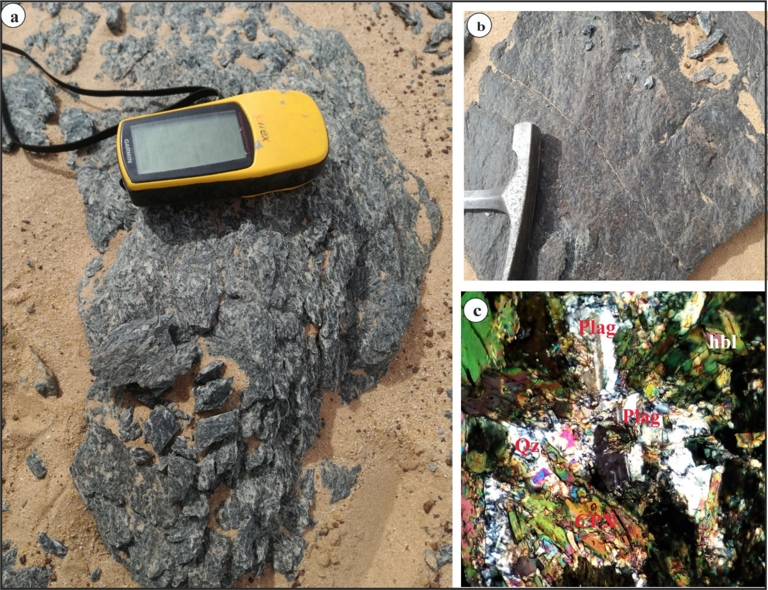
Photographs of the metabasalts from the greenstone belt in the Tasiast area. (a–b) Highly Fractured metabasalt Coated with Desert Varnish—Lebzenia Group. (c) The metabasalts are composed mainly of plagioclase and clinopyroxene, with secondary amphibole formed by the alteration of pyroxenes.
Under the microscope, these metabasalts are primarily composed of plagioclase and clinopyroxene, with secondary amphiboles resulting from the alteration of pyroxenes (Figure 2c). The matrix consists of fine-grained minerals, mainly plagioclase and clinopyroxene, associated with opaque phases. Accessory minerals such as epidote, zoisite, chlorite, sphene, zircon, apatite, and ilmenite are also present.
Various textures are observed, reflecting the magmatic and metamorphic processes that have affected these rocks. The porphyritic texture is the most common, characterised by plagioclase and clinopyroxene phenocrysts embedded in a fine-grained matrix (Figure 2c). Some samples also exhibit a sub-ophitic texture, where clinopyroxene crystals partially enclose plagioclase grains (Figure 2c). The preferential mineral orientation observed in certain sections suggests deformation and recrystallisation processes related to the tectonic evolution of the region (Figure 2a).
5. Geochemistry
The metabasalts of the Lebzenia Group, located within the Tasiast Complex, provide key insights into the geological evolution of this region. Their geochemical analysis reveals a wide range of basaltic compositions, ranging from transitional to calc-alkaline, based on the Th/Yb vs. Zr/Y ratios, using the magmatic affinity diagram of Bédard (2009) (Figure 4).
These metabasalts have SiO2 contents ranging from 46.91 to 51.57 wt%, with a relatively high magnesium index (Mg#), ranging from 37 to 61. They also have notable concentrations of TiO2(0.40 to 1.05 wt%), Fe2O3t (7.32 to 16.31 wt%), CaO (9.34 to 12.23 wt%), and MgO (5.18 to 6.94 wt%), distinguishing them from the basaltic metavolcanites of the Sebkhet Nich and Talhayet formations (Table 1). These characteristics place most of the samples within the basalt-andesite fields on the Zr/TiO2 vs. SiO2 diagram (Figure 3).

Zr/TiO2 vs. SiO2 diagram for the Tasiast area the metabasalts (Winchester and Floyd, 1977).
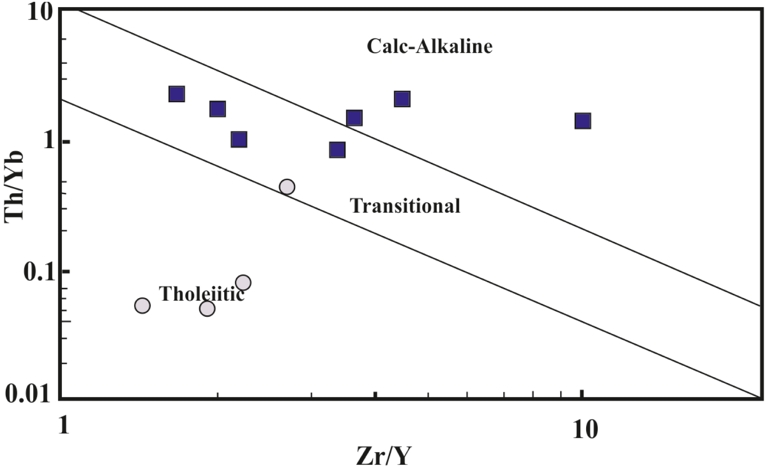
Discrimination of the metabasalts of the Lebzenia Group in the Tasiast area based on trace elements, using the Th/Yb vs. Zr/Yb diagram of Bédard (2009). The rocks are predominantly calc-alkaline. The greenstone belts of Talhayet and Sebkhet Nich are presented for comparison with our data (symbols are as in Figure 3).
The analysis of Harker diagrams (Figure 5) highlights well-defined geochemical trends, illustrating characteristic magmatic processes. A gradual decrease in CaO and MgO contents as SiO2 increases reflects a fractional crystallisation process dominated by the formation of calcium-rich plagioclases and clinopyroxene. Furthermore, the relative stability of TiO2 content despite the increase in SiO2 and the decrease in Fe2O3 concentrations with SiO2 enrichment suggest the fractionation of ferromagnesian minerals.
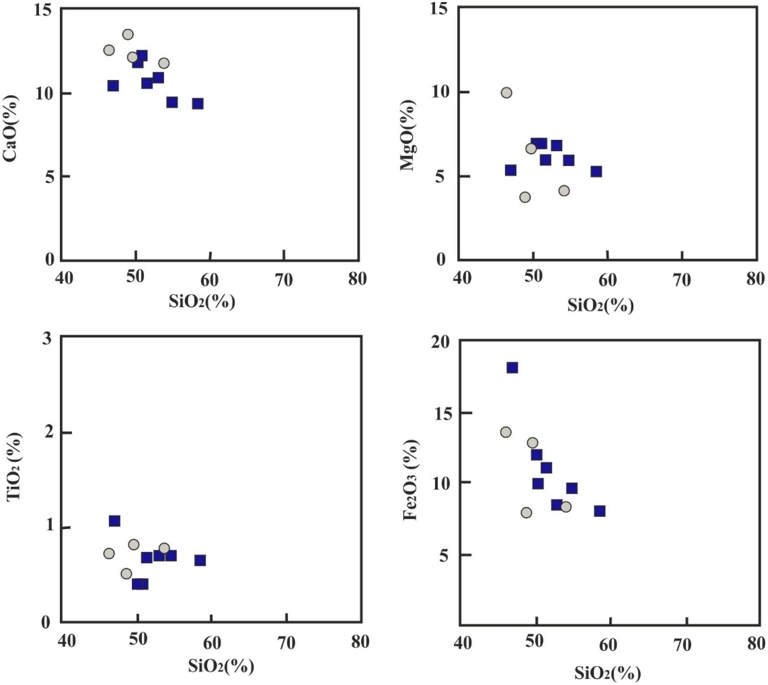
Harker Diagrams for Samples Collected from the Lebzenia Group in the Tasiast area (symbols are as in Figure 3).
The rare earth element (REE) spectra show moderate and homogeneous fractionation, with an enrichment of light rare earth elements (LREE) relative to medium (MREE) and heavy (HREE) rare earth elements (Figure 6a), illustrated by the ratios [(La/Sm)N = 1.7–4.4, (La/Yb)N = 1.9–8.6, and (Gd/Yb)N = 1.02–2.16]. As for the trace element spectra, normalised to the primitive mantle (Figure 6a), they show an enrichment in Th. There is a large variation in the La/Nb ratios (0.97 to 62.28), a depletion in Nb–Ta (Nb/Nb* = 0.05–0.30), and a slight negative anomaly in the Zr–Hf level (Figure 6a).
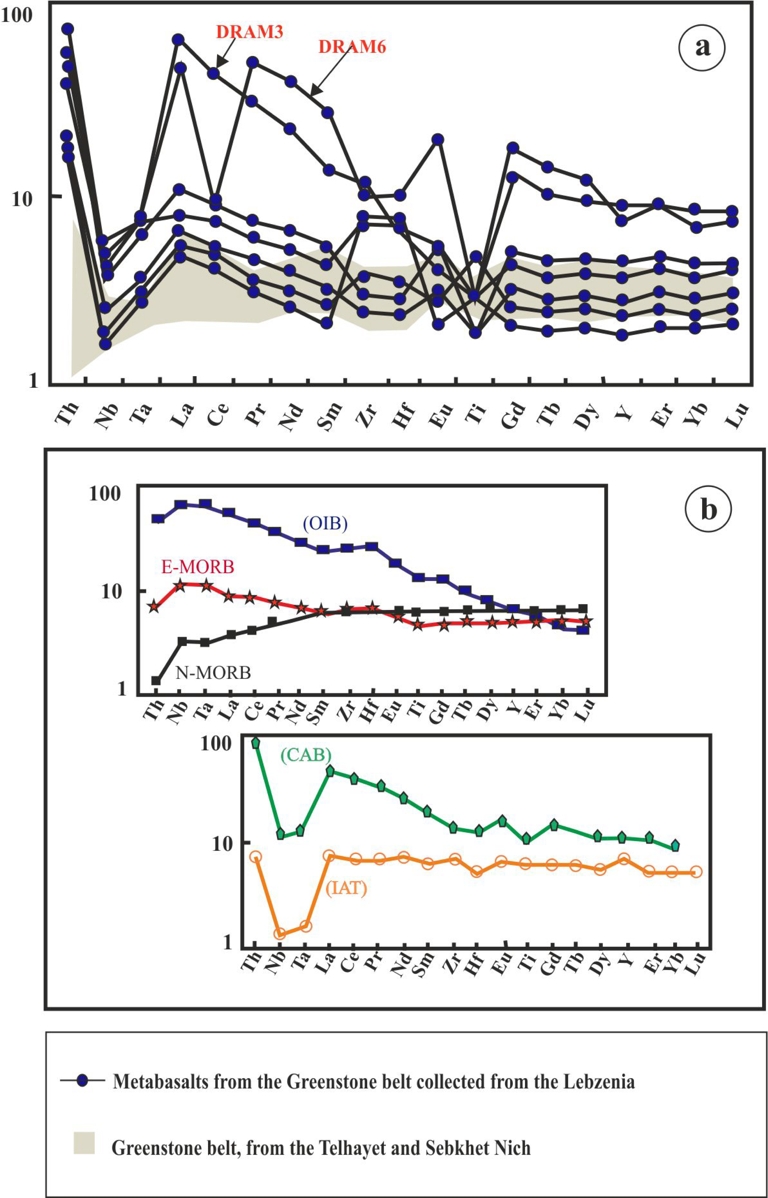
(a) Primitive mantle-normalized normalized trace element patterns of the Tasiast metabasalts, based on the normalisation values proposed by Sun and McDonough (1989). (b) Normal and enriched mid-ocean ridge basalt (N-MORB, E-MORB) and ocean island basalt (OIB) from Sun and McDonough (1989); Calc-Alkaline Basalt (CAB), average of Sunda, Flores and Mandiri, from Stolz et al. (1990); Island Arc Tholeiite (IAT) from Tonga, after Turner and Hawkesworth (1997) (symbols are as in Figure 3).
6. Discussion
6.1. The magmatic genesis of the Lebzenia Group metabasalts
Basaltic samples from the greenstone belts of the Lebzenia Group, located in the Tasiast region of Mauritania, exhibit geochemical characteristics indicative of a complex magmatic genesis. The low concentrations of incompatible elements such as Nb, TiO2, and P2O5 (Figure 7b) are typical of magmas formed in environments associated with volcanic arcs (Defant et al., 1992; Sajona et al., 1996; Kepezhinskas et al., 1997). The samples are enriched in large-ion lithophile elements (LILE) and depleted in high-field strength elements (HFSE) relative to light rare earth elements (LREE), while exhibiting negative Nb-Ta anomalies, characteristic of igneous rocks associated with volcanic arcs (Figure 6a) (McCulloch and Gamble, 1991; Pearce and Peate, 1995; Kelemen et al., 2007). However, sample DRAM2 shows a strong negative anomaly, indicating magma that has undergone plagioclase fractionation (Figure 6a). In addition, the LREE enrichment observed in samples DRAM3 and DRAM6 suggests a differential melting process, involving a garnet-rich peridotite source in which HREE was preferentially trapped, changing the chemical composition of the resulting rocks (S. M. Kay et al., 1994; Haschke and Günther, 2003).
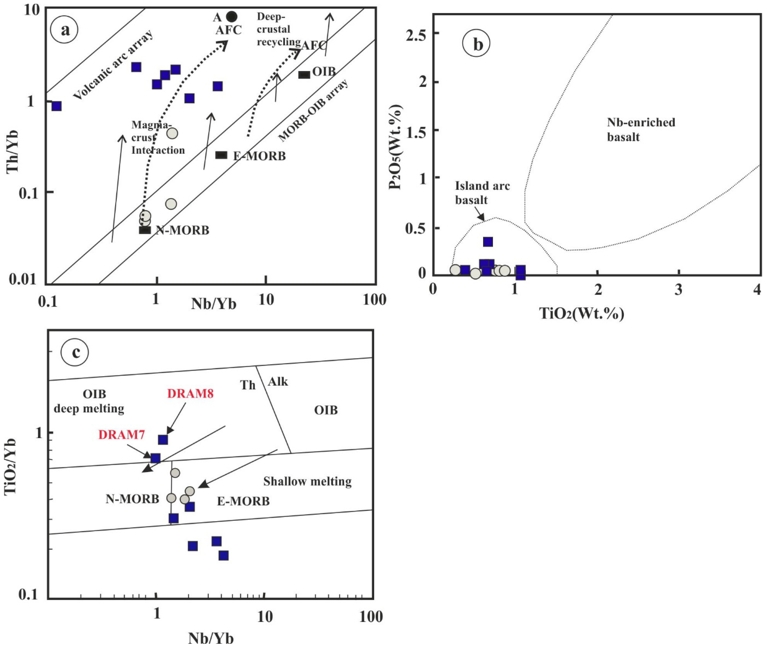
(a–c) Pearce (2008) diagrams illustrating variations in mantle source composition (Nb/Yb), the influence of subduction or crustal contamination (Th/Tb), and melting depth (TiO2/Tb). (b) P2O5 (wt%) versus TiO2 (wt%) after Defant et al. (1992). A = Archaean crust, from Pearce (2008). The generic assimilation–fractional crystallisation (AFC) curves are from Pearce (2008) for N-MORB and more enriched magmas, each contaminated with Archaean crust. Th = tholeiitic; Alk = alkaline; MORB = mid-ocean ridge basalt; OIB = ocean island basalt. Masquer
(a–c) Pearce (2008) diagrams illustrating variations in mantle source composition (Nb/Yb), the influence of subduction or crustal contamination (Th/Tb), and melting depth (TiO2/Tb). (b) P2O5 (wt%) versus TiO2 (wt%) after Defant et al. (1992). A = Archaean crust, from ... Lire la suite
Two main hypotheses can explain these characteristics: (1) An active subduction context: The magmas may have originated from mantle melting in a magmatic arc environment, related to either oceanic or continental subduction (McCulloch and Gamble, 1991; Pearce and Peate, 1995; Kelemen et al., 2007). (2) Crustal contamination: The interaction of magmas with pre-existing continental crust could explain the high Th/Nb ratios (>0.2) and the negative Nb, Ta, and Ti anomalies (Lightfoot et al., 1990; Pearce, 2008).
The geochemical signatures of the Lebzenia Group metabasalts can be interpreted in terms of different tectonic environments. Although Nb–Ta anomalies are typical of arc magmas, the lack of direct evidence for an active subduction zone suggests an environment of mature continental rifting or a thinned continental margin (Wilson, 1989). However, the specific data from the Lebzenia Group basalts allow us to rule out one of these two hypotheses.
Th/Nb ratios greater than 0.2, consistent with Pearce (2008) criteria, indicate that these samples have undergone significant crustal contamination, likely from a Th-enriched Archaean crust. Similar geochemical features have been identified in peri-Atlantic Triassic dolerites (Marzoli et al., 2019), as well as in Cambrian metabasites associated with the opening of the Iapetus Ocean (Ouali, Briand, El Maâtaoui, et al., 2001; Ouali, Briand, Bouchardon, et al., 2003).
The samples with transitional calc-alkaline characteristics exhibit a distinct trend of assimilation and fractional crystallisation (AFC), suggesting a potential influence on the Archaean crust or contaminants (Figure 7a). These potential contaminants show enrichment in Th, high values of light rare earth elements relative to heavy rare earth elements, and negative Nb–Ta–Ti anomalies. Samples DRAM7 and DRAM8 plot within the tholeiitic OIB field on the TiO2/Yb vs. Nb/Yb diagram (Figure 7c). These observations suggest a mantle melting event occurring at greater depths, probably in an asthenospheric mantle influenced by a mantle plume (Pearce, 2008).
We propose that the basalts of the Lebzenia Group originated from the asthenospheric mantle but were contaminated by a Th-rich Archaean crust during their ascent. The formation of the Lebzenia Group does not require the presence of a volcanic arc or a subduction zone.
6.2. Comparison with other metabasalts in the Tasiast region
Our samples exhibit geochemical profiles similar to those observed in modern volcanic arcs. These profiles are characterised by an enrichment of light rare earth elements (REE), elevated concentrations of thorium (Th), and negative anomalies in Nb–Ta ± Ti (Figure 6a,b). These characteristics are typical of magmas generated in subduction zones, where the mantle source is enriched by fluids derived from the crust.
In contrast, the formations of Talhayet and Sebkhet Nich display geochemical characteristics more akin to those of modern N-MORB. These rocks are characterised by relatively low concentrations of incompatible elements such as Nb, Ta, Th, and La (Figure 6a) and are distinguished by a low Nb/La ratio as well as a very low Th/Nb ratio, suggesting that they have not been influenced by crustal contamination. In addition, the REE patterns of these formations show a flat slope, with almost no Nb–Ta anomaly, in sharp contrast to the characteristics of arc magmas (Figure 6a,b).
Modern N-MORB, although formed in environments similar to those of E-MORB, are derived from a more depleted mantle source (ibid.). The geochemical differences observed in our samples suggest that the Lebzenia Group metabasalts have a distinct geological history from the rocks of the classical-formations studied.
The exact age of the metabasalts of the Lebzenia Group remains uncertain, but it could be comparable to that of the schistose metadacites with plagioclase phenocrysts of the Aouéoua Formation. These rocks exhibit a geochemical signature typical of volcanic arcs, characterised by a pronounced negative Ta–Nb anomaly, indicating a subduction-related magmatic setting (Pittfield et al., 2005). They also have a high SiO2 content (73.8%), reflecting a significant degree of magmatic differentiation, which accounts for the elevated concentrations of Zr and Hf (ibid.). Their geochemical profile is marked by an enrichment in light rare earth elements (LREE), suggesting an extended fractional crystallisation process (ibid.). These metadacites have been dated to approximately 2.968 Ga (Pittfield et al., 2005; R. W. Kay et al., 2008), providing a potential temporal framework for the associated basaltic formations.
Furthermore, our results highlight specific geochemical anomalies that may indicate particular formation processes or tectonic contexts unique to the Tasiast region, suggesting a distinctive geological dynamic for this area.
7. Conclusion
The geochemical analysis of the basaltic samples from the Lebzenia Group in the Tasiast region reveals a complex magmatic history, with signatures indicative of significant mantle melting and crustal contamination. The observed enrichment in light rare earth elements (LREE), elevated thorium (Th) concentrations, and negative Nb–Ta anomalies suggest a magmatic origin in an environment influenced by subduction processes. However, the presence of crustal contamination, as evidenced by high Th/Nb ratios and distinct calc-alkaline characteristics, suggests a more complex tectonic setting, possibly involving a mature continental rift or a thinned continental margin, rather than a traditional volcanic arc.
The comparison with modern N-MORB and E-MORB further supports the idea of a mantle source which produced a basalt that was enriched during ascent through a Th-rich Archaean crust, rather than originating from an active subduction zone. These findings, coupled with the distinct geochemical anomalies in the Lebzenia Group basalts, provide new insights into the tectonic evolution of the Tasiast region, and suggest that the region may have experienced unique processes of magmatic differentiation and crustal interaction.
The results highlight the need for further studies to better understand the complex interactions between mantle processes and crustal contamination in the formation of the Lebzenia Group basalts. Our results open new perspectives on the geological dynamics of the region, which could contribute to a broader understanding of the tectonic and magmatic processes in the Archaean and Proterozoic.
Declaration of interests
The authors do not work for, advise, own shares in, or receive funds from any organization that could benefit from this article, and have declared no affiliations other than their research organizations.
Acknowledgements
This article was funded by the FP7-PEOPLE-2013-IRSES MEDYNA project: Maghreb-EU research staff exchange on geodynamics, geohazards, and applied geology in Northwest Africa 2014-2017, WP3 - Deep structures and mantle processes. We would like to express our deep gratitude to Carlos J. Garrido, co-coordinator of MEDYNA, for providing access to the analytical facilities of the Department of Petrology, Geochemistry, and Geochronology (PGG) at IACT-CSIC in Granada. We also warmly thank all the members of the PGG for their invaluable help in sample preparation and their assistance during the laboratory work.





 CC-BY 4.0
CC-BY 4.0